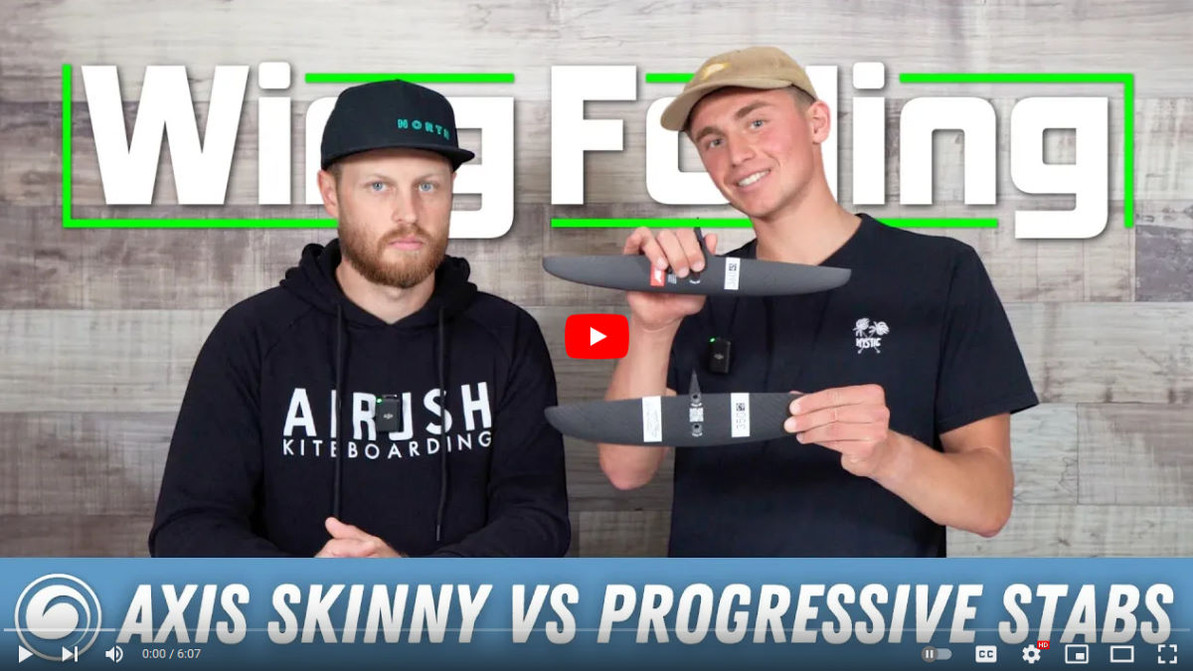Axis Skinny vs. Progressive Stabilizers
Ryan and Cole talk about some new Axis stabilizers, who they're for, and why you might want one in your setup.
Ryan: A lot of times, the stabilizer choice gets overlooked, but it's a great way to upgrade your foil or change some characteristics about it. So today we're going to look at the Axis Progressive series stabilizers versus the Skinny series and what some of the differences are that you're going to notice when you switch back and forth between the two styles.
Axis Skinny Series Stabilizers
Cole: Just looking at the shapes, the first thing that you are going to notice between these two stabilizers is that the Skinny is a lot skinnier than the Progressive. Obviously, that's why they called it the "Skinny". Ryan, what is the Skinny going to help you out with?
Ryan: Similar to what you'll notice in front wings, when you're comparing performance in stabilizers and go with a higher aspect ratio stabilizer, you're going to get less drag and generally higher speed. It's a great way to go if you're charging and ripping some big waves, or perhaps you want to get a little more glide out of the foil that you currently have. Since this is more of a high-speed stabilizer, there are certain front wings from Axis that you wouldn't necessarily pair this with, like a PNG foil, or definitely not their BSCs, but there are also a lot of foils that would work great. Some of them might even get overlooked, like their new Spitfire. A lot of people might not think to put the Skinny stabilizers on the Spitfire wing, but recently I've been pairing the smaller, higher-aspect stabilizers with a lot of foils in order to get more glide out of whatever front wing it is that I'm riding.
Cole: The biggest thing I've noticed with the Skinny is that they really excel for pumping. I like them a lot. The higher aspect stabilizers definitely tend to pump better than something like the Progressive with a little thicker chord length. Like Ryan said, the narrower stabilizers let you go faster. Sometimes those thicker stabilizers feel like the brakes are being put on. If you use a small front wing and your stabilizer is too big, you're going to feel those brakes getting applied, so that's where those skinny ones really shine.
Ryan: I think a lot of people notice that when they make the jump from something like a Progressive wing down to a Skinny wing; it feels like someone took the parking brake off. All of a sudden, they've unlocked a whole new speed level that they didn't know was there in their wing, so it's a really easy way to modify your foil if you're not looking to get a new front wing or don't want to mess with the fuselage because you like how stable it is. Stabilizers are an awesome thing to play with.

Axis Progressive Series Stabilizers
Ryan: The Progressive series have a little more chord length, or a little lower aspect ratio, so you're going to get a shorter wingspan on your Progressive stabilizers than what you would in the Skinny series.
Cole: Right, assuming that you have the same surface area on your tail wing.
Ryan: Correct. So the Progressive stabilizers are going to open up those turns for you and allow you to turn a little more aggressively than what you typically could with the Skinny stabilizer.
Cole: It's like having a big, high-aspect front wing versus something that's a little bit more compact. Those high-aspect, big-wingspan front wings don't like to turn side to side. The same thing applies to your stabilizer.
Which Is Right for Me?
Ryan: If you're looking to upgrade your foil or change a few things around, don't over-complicate it. When it comes to the stabilizers, the concepts are very similar to what they are with the front wings in terms of what you're going to notice performance-wise. Keep it basic and try a few things out. It's an easy way to change your foil up and unlock a whole new level of performance without making any major changes.
Cole: It's also a cost-effective way to enhance your foil experience. Rather than buying a whole new setup, you can pick up a stabilizer and it'll change the way that your foil rides.
Ryan: The Progressive series is for someone that wants something that's a little more surfy and toe-to-heel. Maybe you're not concerned about unlocking your foil's full potential in terms of speed, but are more concerned about how well it carves.
Cole: On the other hand, if you're looking to go fast, the Skinny is the best option for you. If you're looking to pump, this is also a great option for you. But if you're looking to turn, the Skinny doesn't love to turn side-to-side too well, however, the smaller sizes of the Skinny do have a short enough wingspan to where you can still rip some turns on it. If you have any other questions, feel free to reach out to us via live chat, phone, or email. Until next time, we hope you have a fun time out on the water!

MACkite Subscription Links:
YouTube | Instagram | Spotify Oddcasts
Contact MACkite Below:
800.622.4655 | Kiteboarder@MACkite.com | LIVE Chat Messenger


Recent Posts
-
Kiteboarding Tricks | How To Do A Backroll Hat Drag
You can use a little creativity to switch up even the more basic tricks and add a little f …26th Jul 2024 -
KT Ginxu Step-Bottom and Foil Drive Systems | A Perfect Match?
The step-bottom feature of the KT Ginxu foilboards is a big help in releasing the surface te …24th Jul 2024 -
Starboard Ace Air Inflatable Wing Foilboard Review
It's Wing Wednesday, and today Tucker's got an inflatable foilboard, the 2024 Starboard Ace …23rd Jul 2024




